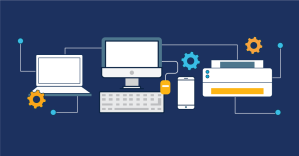“What technology will be shaping our lives between now and 2030?”
This question was posed to 800 experts at the World Economic Forum in 2017. They came up with a list of seven technologies to watch over the next decade. Vala Afshar, Chief Digital Evangelist at Salesforce, added three more in his retweet of the list.
Vala Afshar
10 Technologies of the Next Decade
- #AI (Machine learning, NLP)
- #IoT
- smart robotics
- 3D print
- mobile
- autonomous cars
- mobile internet
- blockchain
- mixed reality VR/AR
- wireless power

Here’s a look at the top 10 technologies of the next decade. Get ready for some big changes.
AI (Machine Learning, NLP)
We’re in the midst of an artificial intelligence (AI) revolution. AI is already here, and it’s getting smarter by the day. This technology is to the optimization of human thought what the industrial revolution was to human labour.
Just like the human mind, AI can learn from its mistakes and master increasingly complex tasks. By 2026, AI thinking is predicted to be advanced enough that AI could sit on a corporate board of directors.
The Many Parts of Artificial Intelligence (AI)

IoT
This is also known as the “Internet of Things.” Get ready for smart sidewalks, smart clothing, and an ever-expanding array of smart appliances and wearables.
Sensors are going to be everywhere, synergizing our day-to-day lives. Some of this will be new tech, connecting things that have never been “smart,” but there will also be a much wider adoption of existing technologies, including smart homes and biohacking devices.
As with many of the next decade’s big tech leaps, niche tech is going to become mainstream in this area. To see instances where this has already happened, just look at the Apple Watch or Nike+. It’s en vogue for people to monitor their running and walking habits. A few years ago, this sort of thing was reserved for tech-savvy triathletes.
Smart Robotics
The next decade will be a time of great social mobility… for robots. Having already disrupted blue collar jobs such as auto manufacturing, advanced robots will begin to augment and improve human labour in more sophisticated fields. In fact, robots have been alleviating pharmacists’ workloads in multiple facilities.
3D Printing
Some of the most exciting uses for 3D printing could be in medicine, where it has already been used to repair a ribcage. In fact, research shows “the 3D bioprinting market will reach $6 billion by 2024.”
If you have any doubts that this is the most exciting time in history to be alive, just ask the recipient of the world’s first 3D printed kidney transplant.
Beyond the medical field, consumers can look forward to increasingly affordable 3D printers they can use at home. This technology will allow them to print products purchased online.
The Basics of How 3D Printing Works
- Take an original object.
- Use CAD software to digitize the object. CAD stands for computer-aided design and drafting.
- The 3D printing software digitally slices the object into layers. If the object needs to be detailed, thinner layers must be used.
- For metal objects, the printer deposits a powder layer by layer. A laser is used to melt the powder together and form a solid.
- The 3D printed model is put in a bath to dissolve any extra materials.
- The product is sanded, painted, or otherwise finished.

Mobile
One obvious prediction is that mobile devices and their components will probably keep getting smaller and more efficient and more powerful.
But are you ready for implanted phones? The experts say they’re coming in the next five or six years. It might sound like the stuff of science fiction, but we could soon have chips implanted in our heads that allow us to communicate by using brain waves, rather than talking.
Even though you may not want phone calls and DMs literally in your head, implanted technology has the potential to revolutionize medical care, giving doctors real-time access to information like glucose levels, blood pressure, and heart function.
Autonomous Cars
The movement toward self-driving cars is coming on the heels of the enormous disruption of transportation and car ownership we’re already seeing with ridesharing. Sixty-seven per cent of the World Economic Forum’s experts believe the number of shared rides will overtake travel in privately owned vehicles by 2026.
When it comes to self-driving cars, Alex Davies in WIRED puts it this way: “In the past five years, autonomous driving has gone from ‘maybe possible’ to ‘definitely possible’ to ‘inevitable’ to ‘how did anyone ever think this wasn’t inevitable?’”
Investment in self-driving car technology is coming from a variety of sources, including the big automakers, Tesla, tech companies (particularly ones already invested in mapping and satellite technology, such as Google), and ride-sharing services. The obvious military applications mean there will likely be serious funding from governments as well, and the U.S. military has already started experimenting.
Mobile Internet
Once upon a time (just two decades ago), you had to be at home to make a phone call — that is, unless you were cool enough to have one of those clunky wireless phones connected to your car. We now take it for granted that there’s mobile phone coverage almost everywhere.
The same is happening with mobile internet, and inflight WiFi is just the beginning. The dominance of mobile devices is fueling a demand for fast and free internet everywhere on the planet.
At the same time, the laws governing access to the internet are expected to change. Seventy-nine per cent of those polled by the World Economic Forum believe internet access will be considered a basic right by 2024.
Until that happens, the manufacturers of mobile devices, as well as the platforms they connect to, will continue to invest in and acquire networks and means of accessing the internet.
Blockchain
The history of innovation is marked by tech developed for one thing and used for another. The microwave, sticky notes, and x-rays were all discovered accidentally or in the search for something else. A book called Brilliant Blunders chronicles the history of these accidental discoveries.
Right now, many people think of blockchain as synonymous with cryptocurrency, but it may have some powerful other uses that haven’t yet been discovered. It has already shown promise as a means of identification, a way to guarantee privacy, and even as a form of tamper-resistant digital voting. In spring of 2018, Sierra Leone held the first blockchain-based election.
That’s not to say cryptocurrency itself isn’t a big deal. In a matter of just a few years, the cryptocoin gold rush has minted many new millionaires and has forced us to reimagine how markets work. Bitcoin and its competitors could be to central banks and treasuries what ride-sharing has been to the taxi business.
Of all the blockchain projects in the works, one of the most “out there” is Sweatcoin. They’re monetizing the healthcare and productivity savings of exercise by paying people to walk every day. The steps users take — recorded by their smartphones — can be converted into credits for online shopping.
How Does Blockchain Work?

Mixed Reality VR/AR
We already have a number of novelty applications of virtual reality (VR): video games, social media filters, or the man in Australia who used VR to propose to his girlfriend. But there’s a big shift happening toward more practical, everyday uses of VR and augmented reality (AR).
One example is a newly designed smart construction helmet that can take in information from a construction site and relay instructions in real-time to the worker who’s wearing it. Imagine it as sort of like a fighter pilot’s head-up display.
Augmented reality may soon give us the ultimate wearables, with no helmet required. In 2016, Samsung filed a patent for contact lenses that contain a camera and project images onto the wearer’s field of vision. They are controlled by blinking.
This is the first step toward a world where we live our lives in a “mixed reality” of VR, AR, and real life. Someday soon, AR contacts might be able to do everything a phone does, revolutionizing commerce and communication.
Wireless Power
Chargers may soon be going the way of wired headphones. Last year, the FCC approved the first “power at a distance” charging system, which can charge a device from up to three feet away using radio waves. Once the charger goes to market, it’s expected to be universal and allow you to charge multiple devices from a single base.
Furthermore, engineers at the University of Washington have developed a phone that doesn’t need to be charged. It draws its power from ambient radio waves and light. And by 2029, we could see batteries that charge by “breathing” in carbon dioxide. Wireless power may not seem as exciting as AI, but it may be just as powerful.
Closing Thoughts
We are living in one of the most exciting and dynamic times in human history, and these tech trends confirm it.
The big theme that all these innovations have in common is their transition from niche tech to unlocking new eras of human progress, comfort, and happiness. The next 10 years are going to bring us tech that will seem like magic, but be a basic part of our lives at the same time.
Tech geeks everywhere can rejoice, too, that these technologies are developing so quickly that we won’t have to wait long to see the future we’re building for ourselves.
Share “A Quick Rundown of the 10 Technologies of the Next Decade” On Your Site



























